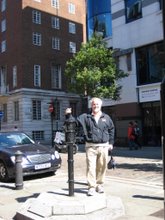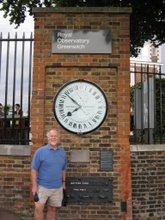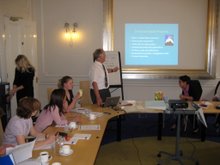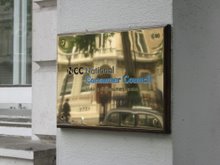12-13 July
Days 13 and 14
Some new acronyms that may crop up from time to time:
PCT – Primary Care Trusts (covering all parts of England and receive budgets directly from the Department of Health (DH). PCTs are responsible for primary care in an area)
SHA – Strategic Health Authorities (Created by the Government in 2002 to manage the local NHS on behalf of the Secretary of State and monitor performance and standards.)
A&E – Accident and Emergency (the equivalent of US ERs or emergency departments)
SITE VISITS
Brighton-Hove
Early on July 12th , Linda and I journeyed to Brighton to join up with member of the NSMC core team scheduled to give training in social marketing. Brighton is a recreation/resort destination of about 250 year-round residents on the south coast of England about 2 hours from London by train. (By the way, the trains here are really on-time, comfortable and not too expensive—about £20 round trip to Brighton). Linda went shopping and touring.
The group gathered at the Brighton-Hove PCT and included about 20 local representative and 5 core NSMC staff (plus me). As I understand it, the NSMC is contracted by DH for 10 demonstration sites, including training of site staff. So this was a “typical” training. The group included: physicians, nurses, nutritionists, health educators, a midwife, advisers, managers, communications officers, coordinators, teachers, trainees and other various professional and organizational representatives. For many this appeared to be the first intensive training in social marketing.
Rowena (Dr. Rowena Merritt) lead the training and used a rather nicely organized and comprehensive workshop agenda. It covered:
This thing called social marketing
Defining behavioural goals (SMART objectives)
Understanding the target audience
Moving beyond promotion-using all 4 P’s
Strategic social marketing
Ethical considerations
Taking an action plan back to work
One of the exercises I liked extremely well was a group collage on the target audience. The instructions asked us to think about our customer (in our case a teen mom who was not breast feeding) and to cut/paste items from various newspapers and magazines on to a sheet of newsprint. We thought of our customer “Jordan” as:
16 years old
White
Living with mother in a tenement house
Divorced parents (since age 9)
Experienced a period in child custody
Smokes
Childs father not around
Passion for handbags
Baby’s name “Brad” tattooed on her arm
Low self-esteem
At risk of another pregnancy
Tied to the house
No clear direction in life
Etc.
Then we choose and discussed pictures and headlines that seemed to reflect this customer. It really made the exercise come alive. Other groups focused on binge drinking young males, smoking teens, HIV risk men and obese teens.
Some broader observations:
One attendee mentioned that research found that only 30% of 4-year-old know their surname, but 70% recognized McDonalds
Several attendees objected to the “Road Crew” program in Wisconsin that provided limos for young men who binge drink on the weekend (27% reduction in crashes) because it promotes binge drinking. They didn’t seem to have a problem with needle exchance (to prevent HIV).
Typical of my experience in the US, a few of the more experienced professionals had difficulty stepping into the social marketing mindset of exploration and “scoping.” Sometimes they would respond to proposals with a kind of “we tried that audit won’t work” sort of comment.
This experience make me wonder how to provide sufficient training and technical assistance to public health professionals doing social marketing in local health agencies—both in the US and the UK. I think it is an important issue that brings together government, academia and practice-based organizations.
After the training, I rejoined Linda and took a bus to the Brighton city center with access to the beach and oceanfront. It was not a typical Brighton-esque day; rather it was cloudy, quite windy and showered from time to time. We only had the opportunity to walk out onto the Brighton pier and have a beer in the outside corner of a pub—sheltered from the fierce wind. The beach and line of houses went on forever both to the east and west of where we sat. The “sand” appeared to be more like marble-sized pebbles and I thought, for a moment to gather a sample for a friend who collects such things. But with no plastic baggie and facing another driven shower, I decided to try again at another location (sorry Brick).
Dudley
The next day, 13 July, I accompanied Rowena to Dudley, a community of about 300,000 in the “Black Country” a region near Birmingham (2 hours by train) known for its industry and historical “black smoke” emanating from factories. We arrived at the modest train station and got a ride to the PCT building.
This was a simple introductory visit involving some orientation and technical assistance. This welcoming group was smaller (about 4 participants) and included a senior manager and her 4 young field staff—mostly nutritionists, I believe. The only previous exposure to social marketing was a briefing by a NSMC leader. The key issue was obesity and access to fruits and vegetables (5-a-Day).
The site proposal clearly outlined the problem as multiple pockets of “deprivation” including widespread socio-economic and health issues. The field team currently conducts “let’s get cooking” program for residents of these areas (and others), but feels that one of the problems is access to fresh foods (as an alternative to packaged and fast foods). We encourage them to use the cooking programs as a way to gather scoping data and building partnerships.
As we worked through the social marketing process (as an orientation) I was impressed by the amount of available data at the community level. Later, they provided us with several extremely well-produced and comprehensive reports about Dudley’s demographic profile, population changes, health inequalities and obesity problem. When the discussion ended, the group agreed to schedule an all-day training on social marketing in the near future. It was clear that this professional staff, like many others in the UK (and certainly in the US) needs training support and technical assistance to launch successful social marketing interventions.
As another broader comment, I have found that my observation about using social marketing to find “an emotional hook” between the product and the customer to be well received both here and in the US. Public health people tend to get focused in on the health issues (maybe as a consequence of the epidemiologic, scientific and clinical orientations). An acknowledgement that people are emotional creatures and that it is ok for us to incorporate that into our planning, seems to be welcomed, maybe even liberating, by most.
###
Tuesday, 17 July 2007
Subscribe to:
Post Comments (Atom)































No comments:
Post a Comment